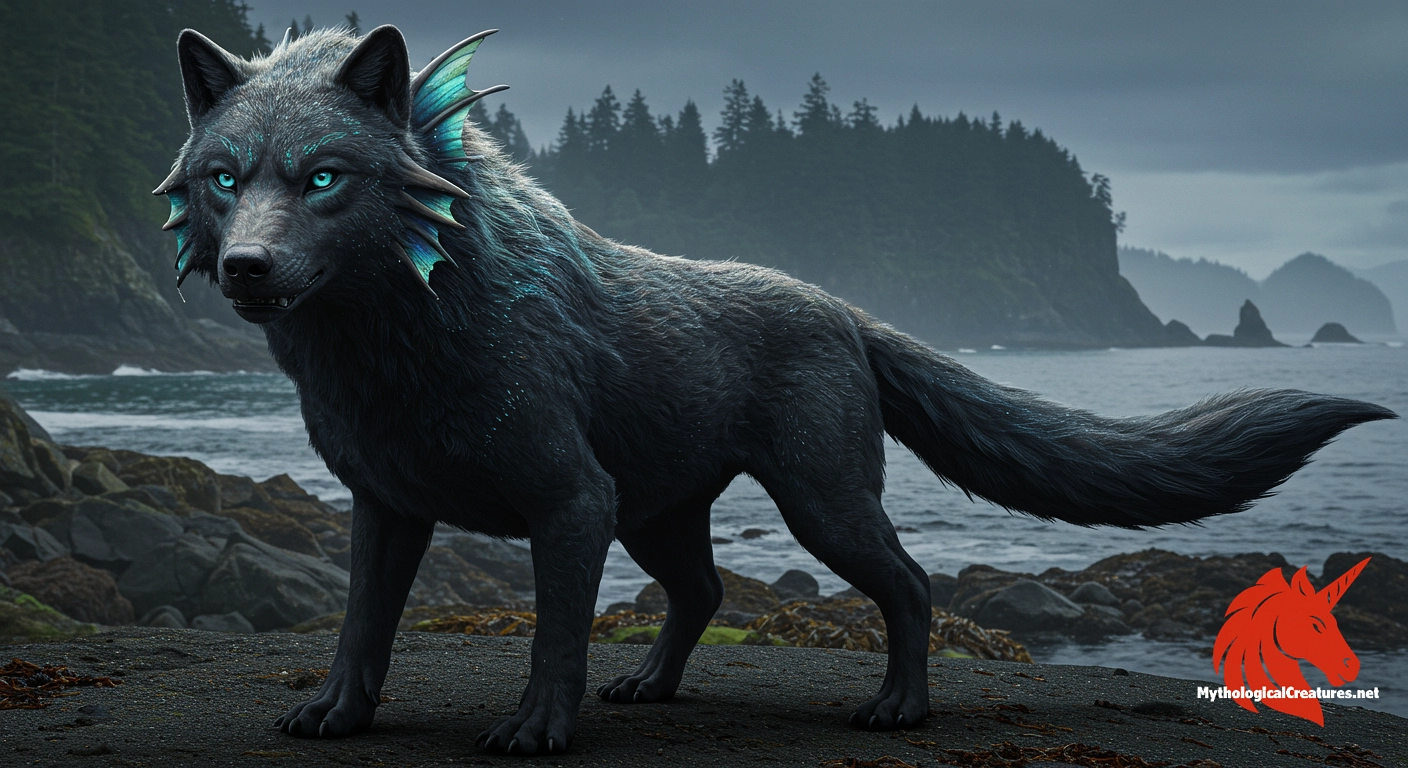Gonakadet: Gonakadet, also known as the Sea-Wolf or Wasgo, is a mythical creature in the Tlingit tradition of the Pacific Northwest Coast.

Gonakadet
Gonakadet - A bearer of good fortune and wealth; a symbol of transformation and benevolence
Origins & First Encounters
Gonakadet, also known as Konakadeit or the Sea-Wolf, is a storied figure deeply embedded in the cultural and spiritual tapestry of the Pacific Northwest. His legend is interwoven with the traditions of the Tlingit, and his alternate name, Wasgo, is cherished by the Haida people. The mythic narrative positions him as a creature of remarkable duality, encompassing both raw strength and gentle generosity. Believed to bring fortune and wealth with just a glimpse or the sound of his soulful howl, he is revered as an omen of prosperity. Stories passed down through generations affirm his origins from human life, later transformed into a majestic sea entity. His early attestations emerged through vibrant oral tradition, long before widespread literary documentation. The enduring narrative has been a source of both spiritual guidance and communal pride among diverse coastal peoples. In a cultural context that celebrates the interdependence of nature and humanity, Gonakadet has become a symbol of mysticism and benevolence. His legacy continues to inspire, reflecting the deep-rooted connection between indigenous communities and the powerful forces of the ocean.
Source Texts & Tale Variants
The primary accounts of Gonakadet are preserved through a rich blend of oral tradition, visual art, and ceremonial storytelling. Indigenous voices including renowned artists have recounted his tale among the Tlingit, Tsimshian, and Haida peoples, each contributing their own unique perspective. Various versions depict him as a sea-monster born from a human existence, sometimes accompanied by the vision of a splendid undersea house. Certain narratives place special emphasis on the transformative nature of his journey, while others focus on his role as a bringer of luck and prosperity. The multiplicity of these story variants highlights the flexible framework of oral lore passed down through generations. Visual depictions carved in totem poles and painted in coastal art further attest to his enduring presence in local culture. These diverse sources have allowed the myth to evolve, with each retelling adding layers of meaning. As such, the legacy of Gonakadet is maintained not only through recited lore but also through artistic expressions and cultural rituals. The intergenerational transmission of his story ensures that the myriad voices of indigenous communities continue to celebrate and reinterpret his mystique.
Form & Powers
Descriptions of Gonakadet often blend the features of both a formidable wolf and a mysterious marine creature, resulting in an image that is as fluid as it is striking. Many accounts evoke the idea of a sleek, muscular presence cloaked in dark, shimmering fur that hints at the deep blues and greys of stormy ocean waters. His eyes are frequently portrayed as luminous and penetrating, reflecting the profound mysteries of the deep sea. Some narratives emphasise elongated limbs and robust stature, suggesting a physical form that bridges human frailty with animal power. In certain retellings, his very appearance shifts, sometimes taking on an ethereal quality that seems to merge with the surrounding waters. The creature’s jaw and teeth are often described in vivid detail, symbolising both the raw, untamed force of nature and an underlying grace. Artistic renditions may highlight subtle features such as rippling skin that mirrors the movement of the tide. The ever-changing descriptions underscore a transformative quality that has both physical and symbolic resonance. Through these varied portrayals, Gonakadet emerges as a being whose physical essence challenges conventional boundaries between the natural and the supernatural.
Regional Faces
The myth of Gonakadet takes on distinct regional variations across the coastal communities of the Pacific Northwest. Tlingit traditions often view him as a guardian spirit whose presence is intertwined with ancestral wisdom and coastal bounty. In contrast, the Haida people refer to him as Wasgo, reflecting a local adaptation that infuses the legend with unique artistic and mythological nuances. Tsimshian narratives, meanwhile, frequently emphasise his metamorphosis from human to sea entity, integrating local experiences and environmental features into the tale. Artistic expressions such as carvings and totem poles frequently exhibit subtle regional differences, from facial features to the style of his depiction. These local adaptations serve not only to reinforce regional identity but also to mirror the varied landscapes of the Pacific coast. Each community’s version is coloured by its own ecological and cultural context, making every retelling rich with indigenous perspective. As a result, Gonakadet’s myth becomes a vibrant mosaic, with each fragment offering insights into local traditions and natural surroundings. The regional diversity in his portrayal ensures that his legend remains dynamic and continually relevant to multiple coastal cultures.
Cultural Parallels
The narrative of Gonakadet resonates with a range of mythological figures who embody the transformative interplay between human existence and animalistic power. His dual origin as both human and sea-monster recalls the shapeshifting legends found in diverse cultures, where the boundary between the natural and the supernatural is fluid. Similar to the Selkie legends of Celtic and Norse traditions, his story explores themes of metamorphosis and the pull of the ocean as a liminal space. Unlike the more cursed werewolf archetypes of European lore, Gonakadet is celebrated as an auspicious presence, heralding good fortune and communal prosperity. This comparison highlights a universal motif in mythology where transformation is both a blessing and a source of mystery. Cross-cultural analysis reveals that many indigenous narratives celebrate hybrids that meld human insight with the untamed aspects of nature. His appearance as a benevolent, yet formidable, creature also finds echoes in other regional tales where natural forces are personified. Such comparative readings allow a deeper understanding of how different cultures articulate the interconnection between humanity and the environment. Through these parallels, the Sea-Wolf emerges as a symbol that spans not only geographical boundaries but also the realms of myth and meaning.
Legacy & Modern Evolution
Over time, the myth of Gonakadet has evolved from a strictly oral tradition into a multifaceted emblem embraced by both indigenous communities and modern society. Early depictions were conveyed through lyrical storytelling and intricate visual art, embedding the creature deeply within the coastal cultural identity. In recent decades, his image has been revitalised, serving as a symbol of resilience, transformation, and the harmonious relationship between man and nature. The adoption of the Sea-Wolf as the mascot of the University of Alaska Anchorage is a modern reinterpretation that cements his legacy in contemporary popular culture. Current artistic renditions in literature, visual arts, and multimedia highlight themes of change and adaptability, mirroring modern ecological and social narratives. The evolution of Gonakadet’s myth reflects a dialogue between ancient wisdom and modern sensibilities, particularly in the context of environmental stewardship. As global audiences reclaim and reinterpret indigenous myths, his legend has become a bridge that connects past and present. The dynamic way in which his story is reshaped underscores ongoing efforts to preserve cultural heritage while addressing modern identity. Ultimately, Gonakadet remains an enduring icon, symbolising not only the mystical allure of the sea but also the timeless capacity for renewal and benevolence.
Interesting Fact
An intriguing facet of Gonakadet is that its inspiration may derive from the coastal sea wolves of the Great Bear Rainforest, merging natural observation with myth to create a lasting symbol of good fortune.
Quick Creature Info
Type:
Origin:
Associations:
Our Mythic Legendary Rating:

Also Sometimes Known As:
Habitat:
Supernatural Powers:
Physical Attributes:
Abilities:
Behavior:
Lore:
References
Discover Another Mythical Legend You May Not Have Heard Of?
Uncover the mysteries of ancient folklore and expand your knowledge of legendary beings from cultures around the world.
Dare to Meet the Fraus....
Mythical Disclaimer: The images and data on this site are derived from various historical and literary sources, but we have found that many myths often have multiple versions and interpretations across references, sometimes contradictory. As a result, these creature depictions are artistic interpretations—imaginative blends of folklore, legend, and a dash of AI guesswork. Because creature descriptions vary widely, our illustrations and accompanying information represent our best effort to honor mythology while bridging creative gaps. Enjoy these interpretations—just remember, we've done our best to respect the stories and validate available data, but in the realm of mythology, details often shift, imagination leads the way, and nothing is ever set in stone!
Curated by the Mythological Creatures Team (rev. May 2025)
